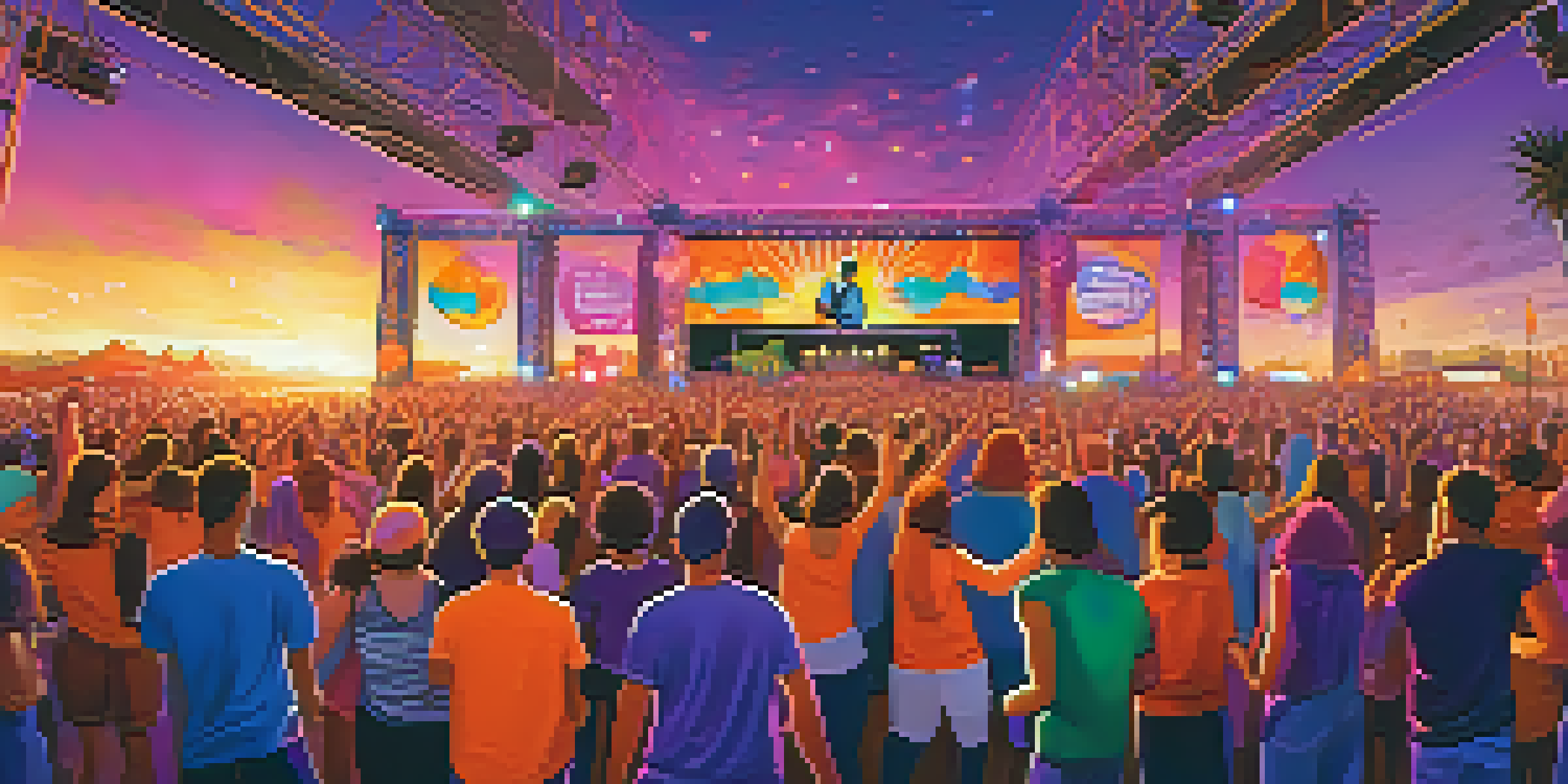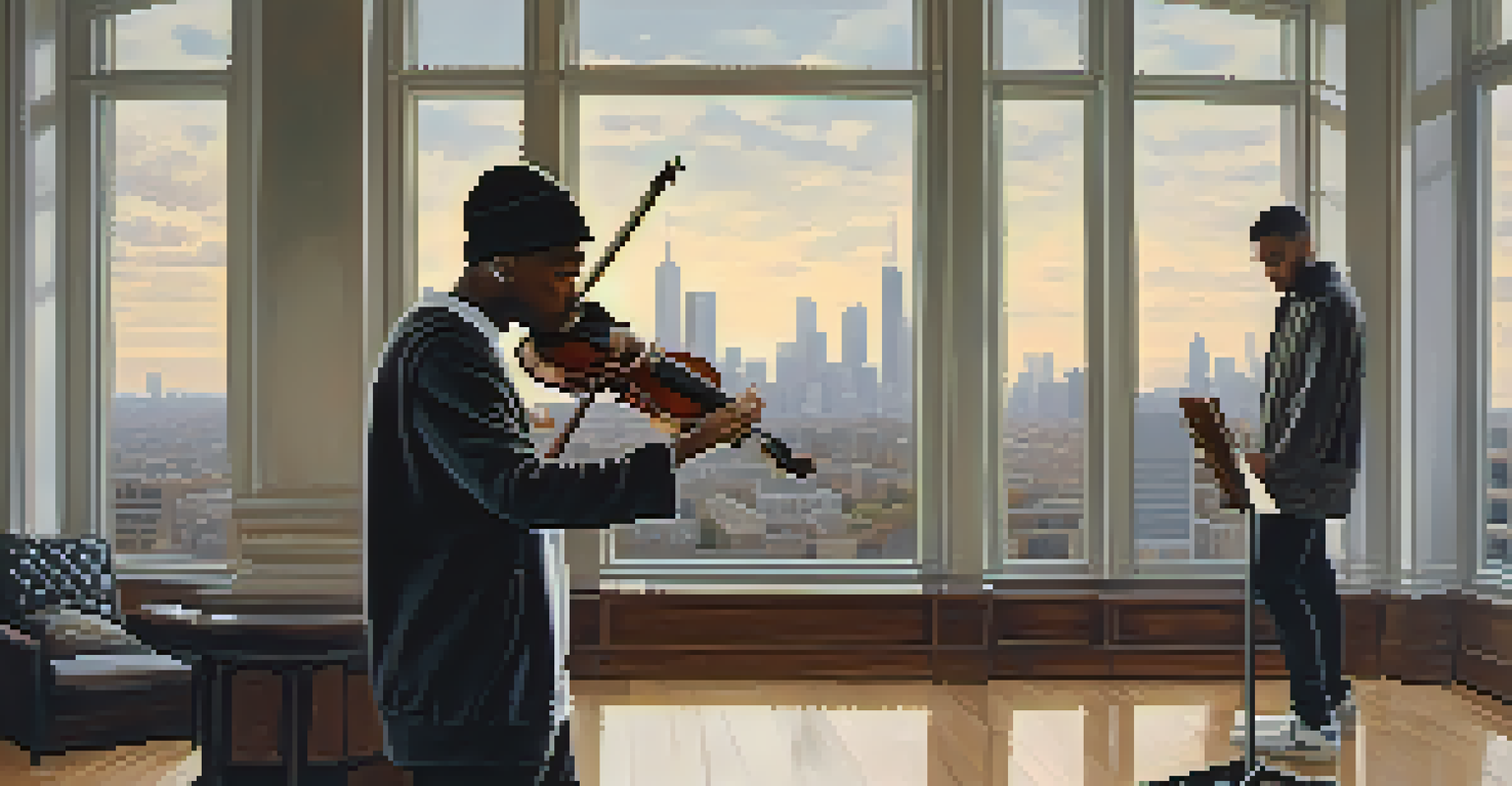The Future of Music Collaborations: Cross-Genre Innovations

The Rise of Cross-Genre Collaborations in Music
In recent years, we've witnessed a remarkable trend in music: artists from vastly different genres joining forces. This rise of cross-genre collaborations has not only enriched the music itself but also expanded listeners' horizons. Imagine a hip-hop artist teaming up with a classical violinist or a pop star collaborating with a heavy metal band—these unlikely pairings are becoming the norm, creating fresh sounds that captivate audiences.
Music is the universal language of mankind.
The blending of genres often brings together diverse fan bases, sparking interest and excitement. For example, the collaboration between Lil Nas X and Billy Ray Cyrus on 'Old Town Road' not only topped charts but also broke barriers, proving that musical boundaries are more fluid than ever. Such innovations invite listeners to explore new musical landscapes and broaden their tastes.
As technology continues to evolve, the tools for collaboration are more accessible than ever. Artists can easily connect online, regardless of their physical location, leading to spontaneous and creative partnerships. This accessibility fosters a culture of innovation, driving musicians to experiment with sounds and styles they may never have considered alone.
Technology's Role in Shaping Music Collaborations
Technology has revolutionized the way musicians collaborate, making it easier for artists to work together from anywhere in the world. With platforms like SoundCloud, Splice, and even social media, musicians can share ideas and create music in real time. This shift not only enhances creativity but also allows for more spontaneous collaborations that reflect current trends and emotions.

Moreover, advancements in music production software mean that artists can experiment with sounds that were once difficult to achieve. Take, for instance, the rise of virtual instruments and artificial intelligence in music creation. These tools enable artists to blend genres seamlessly, crafting unique sounds that capture the essence of multiple influences.
Cross-Genre Collaborations Thrive
Artists from diverse genres are uniting to create innovative music that captivates a broader audience.
This technological landscape encourages experimentation and risk-taking. Artists can try out new styles without the fear of failing in front of a live audience. Instead, they can refine their collaborations in a digital space, leading to polished and innovative tracks that push the boundaries of traditional music.
Impact of Streaming Services on Musical Collaborations
Streaming services have dramatically changed how we consume music, and they've also impacted the way artists collaborate. With platforms like Spotify and Apple Music, artists can easily share their work with a global audience. This increased visibility encourages musicians to explore collaborations, knowing their joint efforts can reach millions in an instant.
The beautiful thing about music is that it transcends language.
Additionally, streaming algorithms often promote diverse playlists that feature cross-genre tracks, exposing listeners to music they might not have discovered otherwise. This exposure can lead to unexpected collaborations, as artists see the potential for their music to resonate with new audiences. The synergy created through these partnerships can lead to innovative sounds that redefine genres.
Moreover, the data provided by streaming services allows artists to understand their audience better. They can analyze which songs perform well and where there’s potential for crossover appeal. By harnessing this information, musicians can strategically collaborate with artists from different genres to tap into fresh markets and grow their fan base.
Cultural Influences Driving Genre Blending
Cultural influences play a significant role in the rise of cross-genre collaborations. As the world becomes more interconnected, artists are increasingly inspired by sounds and styles from different cultures. This exchange fosters creativity and innovation, encouraging musicians to blend genres in ways that reflect their multicultural experiences.
For instance, the fusion of Latin rhythms with pop or hip-hop has led to chart-topping hits and a growing appreciation for diverse musical styles. Artists like Bad Bunny and J Balvin have successfully merged reggaeton with various genres, showcasing the power of cultural exchange in music. Such collaborations not only celebrate diversity but also create a more inclusive musical landscape.
Technology Fuels Music Innovation
Advancements in technology have made collaboration more accessible, allowing artists to experiment and blend genres effortlessly.
As societal norms shift towards embracing diversity and inclusion, music reflects these changes. The collaboration between artists from different backgrounds fosters understanding and appreciation, bridging cultural gaps. This movement not only enriches the music but also strengthens the connections between listeners across the globe.
The Role of Festivals in Promoting Cross-Genre Collaborations
Music festivals have long been a breeding ground for collaboration, bringing artists from various genres together on one stage. Events like Coachella, Glastonbury, and Lollapalooza often feature unexpected collaborations that delight audiences. These moments of spontaneity create magic, as fans witness their favorite artists merging their sounds live.
Festivals also promote a spirit of experimentation, encouraging artists to step outside their comfort zones. Many musicians use these platforms to debut new collaborations, testing the waters with live audiences before releasing studio versions. The energy of a festival setting amplifies the impact of these performances, creating unforgettable experiences for both artists and fans.
Furthermore, festivals often promote diversity in their lineups, showcasing a wide range of genres and styles. This commitment to inclusivity encourages collaborations that might not happen otherwise. As artists share stages and audiences, the possibilities for cross-genre partnerships expand, leading to a richer musical tapestry.
Challenges of Cross-Genre Collaborations
While cross-genre collaborations can lead to innovative music, they also come with their own set of challenges. One significant hurdle is the potential clash of artistic visions. When artists from different genres collaborate, they may have differing expectations and styles, which can lead to creative friction. Navigating these differences requires open communication and a willingness to compromise.
Additionally, there’s the risk of alienating existing fan bases. Longtime fans of a particular genre may be resistant to change, feeling that their favorite artists are straying too far from their roots. Artists must strike a balance between staying true to their original sound while also exploring new creative avenues. This balancing act can be tricky, but when done successfully, it can lead to a broader audience.
Festivals Foster Musical Partnerships
Music festivals serve as a vibrant platform for artists to collaborate and showcase unexpected genre-blending performances.
Lastly, the commercial aspect of music can complicate collaborations. Often, artists must consider marketability and label expectations, which can stifle creativity. However, those who embrace the spirit of experimentation and push past these challenges often find that the rewards—both artistically and commercially—far outweigh the risks.
The Bright Future of Cross-Genre Innovations
The future of music collaborations looks incredibly promising, with cross-genre innovations poised to take center stage. As artists continue to explore new sounds, we can expect even more groundbreaking partnerships that challenge traditional genre boundaries. This trend not only enriches the music landscape but also encourages a culture of creativity and experimentation.
Furthermore, as cultural influences continue to blend, the richness of musical expression will only deepen. The next wave of artists will likely draw inspiration from a broader range of influences, leading to a diverse array of sounds that reflect our interconnected world. This evolution will keep music fresh and exciting, ensuring there is always something new to discover.

Ultimately, cross-genre collaborations are a testament to the power of music as a universal language. As artists embrace collaboration and innovation, they contribute to a vibrant, dynamic musical future that celebrates diversity and creativity. The possibilities are limitless, and we can't wait to see what the next generation of musicians will create together.